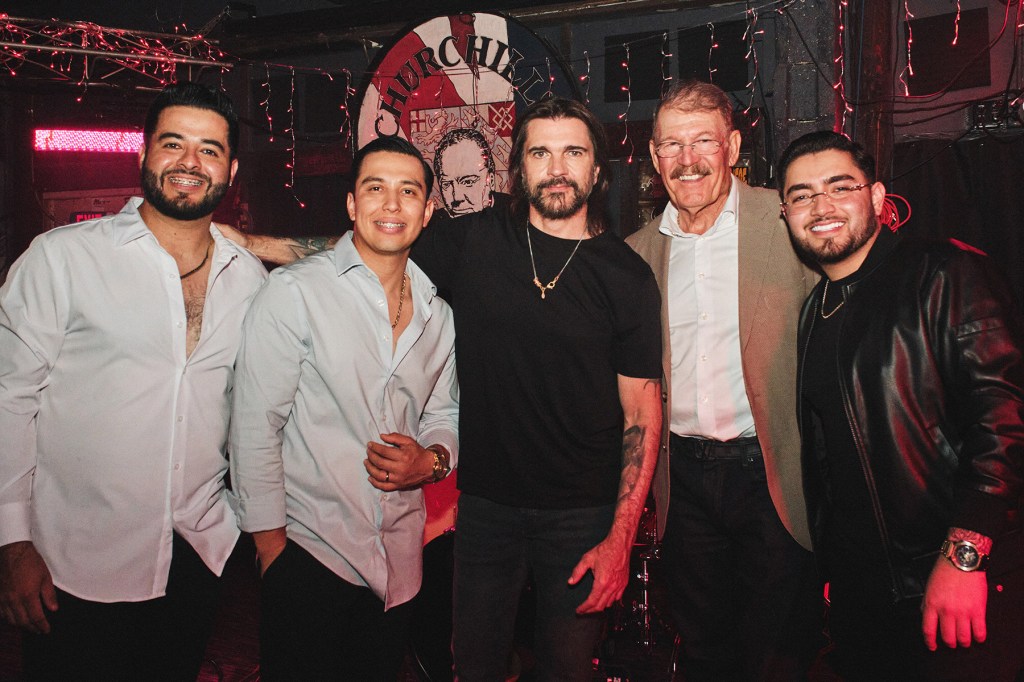Latin
Page: 3
Trending on Billboard
This April, Maria Becerra underwent an emergency surgery for a second ectopic pregnancy that caused severe internal bleeding. For Becerra, it was “very difficult for me to do normal things,” like running, walking and even singing; however, it was this dark moment in her life that ultimately inspired her third studio album Quimera, out today (Nov. 20) under Warner Music Latina.
Explore
See latest videos, charts and news
Home to 17 songs produced by Xross, including the previously released singles “Corazón Vacío,” “Ramen Para Dos” with Paulo Londra, and “JOJO,” Quimera represents the “rollercoaster of emotions” that the Argentine experienced during her hospitalization and recuperation.
Inspired by the mythical creature, chimera, it also inspired four alter egos, each with a set of songs that best characterize them: Shanina, Gladys, Jojo, and Maite.
“The concept started in April, but I had just gone through a very difficult health situation, a huge loss,” she tells Billboard in an exclusive interview. “I was in a very hopeless, sad, and empty emotional state…when you don’t understand that something inside you isn’t working. You don’t understand that something you long for suddenly doesn’t happen. It was a harsh dose of reality. I went through many phases. When I was at my peak of recovery, that was the Jojo moment — unconsciously, everything was connected to my recovery and my emotional states.”
Below, Becerra opens up about her ultra-personal and very vulnerable project:
Maria Becerra
@javifotoman
In QUIMERA you have songs dating back to 2023: How long ago did this creative process begin?
The creative process, conceptually speaking, began in April of this year, with the idea of creating this new album. The truth is that songs like “Corazón Vacío,” “Romántica,” and “Slow it Down” are songs that have been around for a long time, songs that fascinate me, but I really didn’t want to force them onto an album where they didn’t fit. I’ve had “Slow it Down” for six years; it’s one of the first songs I ever wrote.
Why is the name of your album inspired by a creature from Greek mythology?
The Chimera is a monster made up of different animals: a goat, the wings of a dragon, the head of a lion—each animal represents a personality and a strength that contributes to this monster. There are precisely four animals, which are the alter egos that, in a way, act as Maria’s shield and together form this beautiful monster that is the Chimera. Each animal corresponds to a different alter ego.
Gladys is more grounded, more connected to reality; she is the goat. Shanina is the dragon, with Japanese culture, colors, and fantasy. Jojo is the lion, with that fiery personality. The Chimera has another beautiful meaning, which is what gave rise to this album—it’s a somewhat impossible dream to achieve, a distant dream that can’t be fulfilled. It had a lot of meaning for me, not only in music but also in my personal life.
How do you identify with these four alter egos?
All the alter egos are based on my personality. They’re like stages I’ve gone through that have marked me the most. I was Shanina at one point—very toxic, very jealous, very emotionally dependent. I was also Jojo with my excessive partying, my detachment from love, my antisocial nature. I was Gladys too, and Maite, very much so; I think she’s the one who has remained most present in my life—there’s an emotional and dramatic place that’s present in my songs.
In this album, you experiment a lot with tropical genres, including salsa and cumbia. Coming from the urban scene, was this a challenge?
Not at all! I’ve always made bachata from the beginning. Besides, these are genres I feel very connected to because I’m a huge fan of them—salsa, cumbia, bachata, I’ve always loved everything Latin. It was always played a lot at home, I’ve always had those influences, and honestly, I feel like that’s what helped me easily immerse myself in those genres and keep them so fresh in my ears.
You close the album with five songs like “Maria Becerra.” What makes these special?
Maria is the love story I have with my partner. “Slow it Down” is about those typical first encounters, where you feel a strong sexual connection with the person, very passionate, which is what happened in our first encounters with my partner, J Rei. We first connected through chat, through our thoughts and ideologies; that’s where we fell in love. “Slow it Down” represents everything I felt at that moment. “Pierdo la Cabeza” is about being on the verge of falling in love and not knowing how to explain what you’re feeling. In “Tatu,” I’m completely in love; it’s a real relationship. “Romántica” is about a relationship that has developed with a lot of love. And I close with “Mi Amor,” which is about something solid: trying to start a family, our engagement. It’s a song with him to share our experience.
There are 17 songs that convey different emotions: What was your mindset when you created this project?
My state of mind was a rollercoaster. The idea started in April, but I had just gone through a very complicated health situation, a huge loss. I was in a very hopeless, very sad, very empty emotional state. You don’t understand that something inside you isn’t working, you don’t understand that something you long for suddenly doesn’t happen. It was a reality check. I went through many states, the entire beginning of the album: April, May, June… in the months I spent recovering mentally and physically, it was all very sad, dark, very numb, and I don’t know at what point in my mind I associated all that pain with Shanina. She was the first alter ego where I channeled some of my pain with that madness, that cynicism, that darkness, like my thoughts.
As my condition and mood evolved, the other alter egos emerged — at the moment I felt empowered, I started to look good, to regain weight. It was very difficult for me to do normal things; running, walking, singing was incredibly hard after being intubated, regaining lung capacity. When I was at my peak recovery, that was the Jojo moment, unconsciously, everything was connected to my recovery and my emotional states.
Did you ever think about giving up music during your recovery?
It was the opposite. The first intrusive thought, more due to the physical aspect, was that I wouldn’t be able to tour. I was going to have to take a really long break—mental, vocal, and physical rest. It wasn’t throwing in the towel, but it was recognizing that I needed to take a break. And recognizing that I had to be away for months, but in terms of [quitting] music, I never even considered it.
On the contrary, although I did have my dark moments creatively, very sad and dark songs would come out, and I couldn’t get out of that place. That moment alarmed me, and well, being the anxious person I am — I was very vulnerable — I had a creative block, but I never thought about giving up music. The important thing is to let grief flow. I listened to myself a lot, I was very patient with myself, and I went with the flow.
Trending on Billboard
Ricardo Montaner trains as if he were preparing to run a marathon. In February, the iconic Argentine-Venezuelan singer-songwriter will embark on an ambitious tour that will take him across Latin America, the United States, and Europe — a feat that will demand physical and vocal resilience. At the same time, he plans to release of two albums for 2026, he shares exclusively with Billboard Español.
“This tour is not just a return; it’s a renewal of vows,” Montaner says about El Último Regreso World Tour, which kicks off on Feb. 21 in Buenos Aires, Argentina. The trek is named after his latest love song, released on Nov, 6 under his label Hecho A Mano Music.
Dressed in sportswear following a physical conditioning routine at his home in Miami, the 68-year-old artist explains that this tour will take around 18 months. “I just signed perhaps one of the longest tours of my career, with more than 120 performances,” he notes. For this reason, the words “rest” or “retirement” aren’t on his mind. “I’m just a boy,” he jokes.
El Último Regreso World Tour aims to celebrate the artist’s bond with his audience and revisit his career spanning over four decades. The performer of anthems like “Me Va a Extrañar” and “Tan Enamorados” plans to include a couple of 25-minute medley blocks in this new show, featuring iconic songs from different eras. “I want everyone who attends to feel like I sang their song and not leave disappointed because I didn’t perform one or the other,” he says.
The tour begins in Argentina, with shows in the cities of Buenos Aires and Cordoba, and continues in Uruguay, Paraguay, Costa Rica, Colombia, and much of Mexico, where he will perform more than ten shows between April and May. “Mexico is the country where I’ve worked the most, and to cover it, you need to perform more than 15 times,” Montaner explains. Later, he will visit Ecuador, Peru and Chile, before moving on to the U.S. and the Dominican Republic in August and September.
El Último Regreso World Tour will also include a European leg in countries like Spain, France, and Italy. Meanwhile, Montaner will continue adding new music to his discography. The artist reveals he is working on an album featuring pop ballads and other genres, including two singles released this year, “Lo Que Te Dé La Gana” and “Si Tuviera Que Elegir” — the latter featuring his daughter Evaluna and his son-in-law Camilo. In January, a new single will arrive.
“I think that by the time we meet again, people will have heard the latest music, the songs I’ve released over the past two years,” he says, noting that he is simultaneously working on another LP featuring duets of his greatest hits — “a collection of my most iconic songs alongside my most cherished colleagues.”
This album, he adds, will also serve as an introduction to his legacy for younger generations. “I love re-recording my early albums, being able to share with young people what was the foundation of my entire career.”
With a career spanning over 40 years and 25 studio albums, Montaner is one of the most recognized performers in the Latin music scene. He boasts multiple accolades, including a Latin Grammy Lifetime Achievement Award, which he received in 2016, and the Latin AMA Legacy Award in 2024. On the Billboard charts, he has placed dozens of hits on Hot Latin Songs, including the No. 1s “La Cima del Cielo,” “Quisiera,” “Piel Adentro,” and “Castillo Azul,” as well as 17 sets on Top Latin Albums, three of which landed in the top 10.
For more information on the tour, click here.
Ricardo Montaner
Alex Pazmiño
Trending on Billboard
At the 2025 Latin Grammys, Paloma Morphy won the coveted best new artist award, where she was up against promising newcomers such as Alleh of Alleh y Yorghaki fame; Isadora, Chayanne’s talented daughter; and flamenco guitarist Yerai Cortés.
“I feel like the new girl in the classroom,” she told Billboard during Latin Grammys week in Las Vegas. “Seeing all these artists for the first time off-screen was quite shocking, but I’m so happy, excited, and nervous. It’s truly a dream come true. I was scared before coming, thinking it would be full of competition … but I realized we’re all in the same boat. We’re happy to meet each other and support one another.”
Hailing from Mexico City, Morphy discovered her passion for music at a very young age when she joined chorus and talent shows. Aware of her super power, there came a point in her life where she felt spiritless and did not see a career in music viable. So, instead, she pursued a career in law. Her love for music, however, was always present, and after uploading her songs on social media—just as a hobby—Morphy officially stepped into the music realm in 2022 with her debut single “La Idiota Soy Yo.”
“I quit my job as a criminal lawyer to pursue my childhood dream of making music,” she noted. “I said I’d give it two years to see what happens.”
And in those two years, Morphy has not only captivated with her indie-pop sound, charming vocals, and bubbly personality, but she also released her debut studio album, Au, under Sony Music México this year, and was a two-time nominee at the Latin Grammys, ultimately winning the 2025 best new artist trophy.
Paloma Morphy accepts the Best New Artist award onstage at the 26th Annual Latin GRAMMY Awards held at the MGM Grand Garden Arena on November 13, 2025 in Las Vegas, Nevada.
Christopher Polk
“I was very sad and unmotivated, and I don’t know where I got the strength to move forward, but I connected with my dream since I was little that I never thought could be real,” she expressed in the media center backstage on the evening she won.
Moreover, she reflected on her time as a lawyer, admitting to Billboard: “There’s a reason I endured five years of that incredibly boring career, but yes, it gives me a different perspective, and all my songs are based on that experience. So far, I haven’t been able to write about things I don’t feel deeply about.”
Below, learn more about this month’s Billboard Latin Artist on the Rise.
Name: Andrea Paloma Barrios Gomez Álvarez Morphy
Age: 25
Recommended Song: “la mexicana”
“I wrote this song because, during my time working at the prosecutor’s office, I realized how many reports of gender-based violence never even reached the investigation stage. From that perspective, I wrote a song to Mexico as if it were a person I love, because I love my country; it’s beautiful in so many ways, but in this song, I ask Mexico: Why don’t you love me the way I love you? It’s truly my way of raising my voice, and it’s made me reflect on how we can truly make a difference.”
Major Accomplishment: Winning best new artist at the 2025 Latin Grammys, and her debut album, Au, garnering over 28 million streams on Spotify since its release this March.
What’s Next: A new collaboration with Neto Péña and Robot95 releases on Thursday (Nov. 20), in addition to working on new music that she will release in 2026 leading up to her sophomore studio album
Trending on Billboard Bad Bunny‘s “Yonaguni” has surpassed the one billion views on YouTube, earning the Puerto Rican hitmaker his 18th music video to enter the Billion Views Club as a lead, featured artist or collaborator. Directed by Stillz, the visual captures a nostalgic Bad Bunny healing from a breakup but still missing his ex […]
Ozuna, the Grammy-winning Puerto Rican-Dominican música urbana artist, is expanding his empire with the launch of Mucho, a bilingual, video-first media company. According to its website, Mucho is aimed at “amplifying the voices of young US Hispanic audiences” through streaming, talent-driven entertainment, and festivals. The new venture officially kicks off on Tuesday (Nov. 18). Related […]
Trending on Billboard Grupo Frontera announced on Tuesday (Nov. 18) dates for its Triste Pero Bien C*abrón Tour, which kicks off March 28 in Nuevo León, Mexico, and will then make stops in South and Central America and also in Europe. The 27-date stint — Grupo Frontera’s most ambitious trek yet since its 2024 Jugando […]

Trending on Billboard Rosalía appeared on The Tonight Show on Sunday night (Nov. 16) to deliver a captivating performance of “La Perla,” drawn from her latest album, LUX, originally featuring Yahritza y Su Esencia, who were not present for the performance. Explore See latest videos, charts and news The Spanish superstar stunned as she brought […]
Trending on Billboard
Pop star Chappell Roan turned to Duolingo to surprise her fans with some Spanish during her debut in Mexico on Saturday (Nov. 15) night at the Corona Capital festival.
“¡Hola, buenas noches! Me llamo Chappell Roan,” said the singer-songwriter to the 75,000 people (according to promoter Ocesa’s figures) gathered around the main stage at the Autódromo Hermanos Rodríguez in Mexico City. “Are you ready to get ‘Naked in Manhattan?’” she added in English, referencing her song of the same name.
It was the prelude to a grand celebration filled with the dance and synth-pop hits that have made the young singer one of the most celebrated stars today.
Later, seated on a giant throne while holding a gremlin-shaped toy, she revealed more about her attempts to learn the language. “I’m on day 55 of my Duolingo for Spanish, and I practiced saying that sentence in Spanish, and I’m too embarrassed to try and speak it,” she said shyly before performing “Coffee.”
Hundreds of fans responded by chanting “¡Sí se puede!” (Yes, we can!) in unison to try to encourage her. “Chappell, sister, you’re already Mexican!” shouted another group of supporters to applaud her effort, also in Spanish.
On several occasions, Roan interacted with the audience that eagerly awaited her during the marathon day of the musical feast, which also marked the 2025 closing of her Visions of Damsels & Other Dangerous Things Tour, a title that is reflected in her fairytale gothic aesthetic.
“I was really nervous to play this show because I’ve never played in Mexico before,” she confessed. “I wasn’t sure, honestly, what the turn out was gonna be, so I’m glad, thank you for showing up, and this is so awesome!”
Throughout the performance, the singer was literally the queen of a castle that filled the stage. Her often theatrical performance reached a surreal climax when the 27-year-old artist also paid homage to the famous Mexican celebration of Día de Muertos (Day of the Dead), which is held on Nov. 1 and 2 to honor deceased loved ones.
“I wanted to be a screaming banshee, and so I was like, Il’l be scary cause I feel like Mexico City can handle it,” the artists said. “I literally think this is the only place that can handle me looking like this,” she added about her outfit: a bridal gown with veils and lace, her mouth and teeth stained red to simulate blood. (Banshees are female spirits from Irish folklore, described as messengers of death whose wailing or screaming announces the passing of a close relative.)
An enthusiastic audience sang along to every word of her hits, from “Pink Pony Club” to “Good Luck, Babe.” Even the unreleased single “The Subway” and her cover of Heart’s “Barracuda” were a resounding success. The emotion conveyed by the 2025 Grammy winner for best new artist brought tears to the eyes of many of her fans, who expressed their gratitude for her visit. Roan is set to visit other Latin American countries in 2026 when she participates in the Lollapalooza festivals in Chile, Argentina and Brazil.
The second day of activities at the Corona Capital festival also included performances by acts such as Vampire Weekend, Aurora, Marina, Mogwai, Alabama Shakes, Jehnny Beth, Haute & Freddy y Half-Alive. Italian star Damiano David canceled his participation last minute due to health reasons, according to a statement released on his social media.
The program was set to continue on Sunday with Linkin Park, the much-anticipated return of Deftones to Mexico, James, AFI, Weezer, Jerry Cantrell, TV on the Radio, and more.

Trending on Billboard
The first day of the 2025 Corona Capital festival took place on Friday (Nov. 14), marking the grand return of Foo Fighters to Mexico City after a three-year absence. The explosive and unforgettable performance turned into a celebration filled with hits from Dave Grohl’s rock band’s 30-year career.
On day one, the musical feast — which is celebrating its 15th edition — was filled with 1990s nostalgia but also showcased new talents from genres like indie, soul, electro-pop, and folk. It drew over 78,000 attendees (according to promoter Ocesa) who enjoyed performances by Queens of the Stone Age, Franz Ferdinand, Garbage, Kaiser Chiefs, 4 Non Blondes, Jet, Lucy Dacus, Bad Bad Hats, Debby Friday, and other acts. The audience, demanding yet warm, kept the energy and good vibes throughout the day, which stretched into the early hours of Saturday at the Curva 4, the Formula 1 venue in Mexico City.
One of the surprises this year was the performance by veteran band 4 Non Blondes, who won over both old and new fans following the viral trend of the Nicki Minaj mash-up “Beez in the Trap” fused with “What’s Up?” The new song has been used in hundreds of thousands of TikTok videos and brought the ’90s anthem, written by singer-songwriter Linda Perry, back onto the Billboard Hot Rock & Alternative Songs chart.
The program continues on Saturday (Nov. 15) with performances by U.S. star Chappell Roan, whose appearance at Corona Capital marks her debut on Mexican stages, as well as shows by Vampire Weekend, Damiano David, Aurora, Mogwai, Alabama Shakes, Jehnny Beth, Haute & Freddy, Half-Alive, and more.
Find out which were our favorite five acts from the first day of the 2025 Corona Capital festival below.
Foo Fighters, the Best of the Best
Trending on Billboard This week, Billboard’s New Music Latin roundup and playlist — curated by Billboard Latin and Billboard Español editors — features new music, including fresh picks by Laura Pausini and Yami Safdie, La Arrolladora Banda El Limón in a collab with Juanes, HUMBE and DannyLux and more. Música mexicana continues to expand, attracting artists across genres to dabble in the style […]

 State Champ Radio
State Champ Radio 







